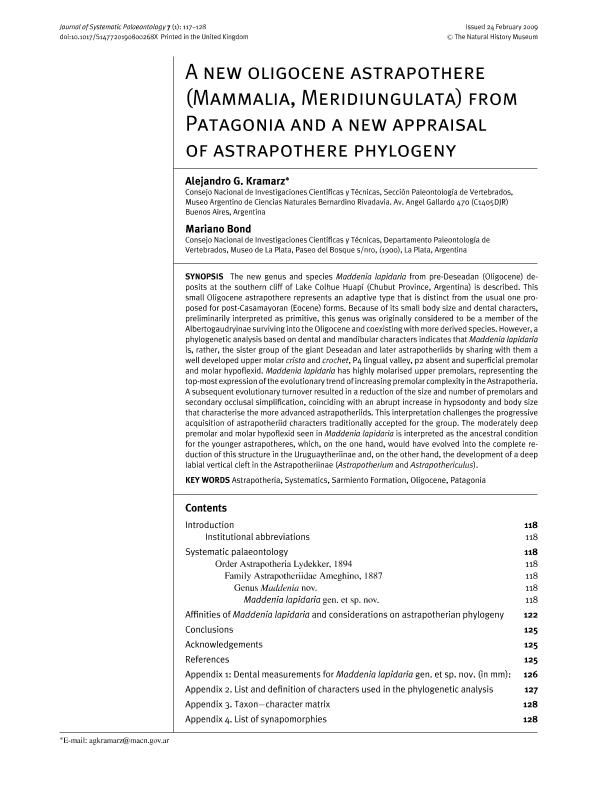Artículo
A new oligocene astrapothere (Mammalia, Meridiungulata) from Patagonia and a new appraisal of astrapothere phylogeny
Fecha de publicación:
03/2009
Editorial:
Cambridge University Press
Revista:
Journal of Systematic Palaeontology
ISSN:
1477-2019
Idioma:
Inglés
Tipo de recurso:
Artículo publicado
Clasificación temática:
Resumen
A new oligocene astrapothere (Mammalia, Meridiungulata) from Patagonia and a new appraisalof astrapothere phylogenySYNOPSIS The new genus and species Maddenia lapidaria from pre-Deseadan (Oligocene) deposits at the southern cliff of Lake Colhue Huap´ý (Chubut Province, Argentina) is described. This small Oligocene astrapothere represents an adaptive type that is distinct from the usual one proposed for post-Casamayoran (Eocene) forms. Because of its small body size and dental characters, preliminarily interpreted as primitive, this genus was originally considered to be a member of the Albertogaudryinae surviving into the Oligocene and coexisting with more derived species. However, a phylogenetic analysis based on dental and mandibular characters indicates that Maddenia lapidaria is, rather, the sister group of the giant Deseadan and later astrapotheriids by sharing with them a well developed upper molar crista and crochet, P4 lingual valley, p2 absent and superficial premolar and molar hypoflexid. Maddenia lapidaria has highly molarised upper premolars, representing the top-most expression of the evolutionary trend of increasing premolar complexity in the Astrapotheria.A subsequent evolutionary turnover resulted in a reduction of the size and number of premolars and secondary occlusal simplification, coinciding with an abrupt increase in hypsodonty and body size that characterise the more advanced astrapotheriids. This interpretation challenges the progressive cquisition of astrapotheriid characters traditionally accepted for the group. The moderately deep premolar and molar hypoflexid seen in Maddenia lapidaria is interpreted as the ancestral condition for the younger astrapotheres, which, on the one hand, would have evolved into the complete reductionof this structure in the Uruguaytheriinae and, on the other hand, the development of a deeplabial vertical cleft in the Astrapotheriinae (Astrapotherium and Astrapothericulus).
Palabras clave:
ASTRAPOTHERIA
,
SYSTEMATICS
,
SARMIENTO FORMATION
,
OLIGOCENE
,
PATAGONIA
Archivos asociados
Licencia
Identificadores
Colecciones
Articulos(CCT - LA PLATA)
Articulos de CTRO.CIENTIFICO TECNOL.CONICET - LA PLATA
Articulos de CTRO.CIENTIFICO TECNOL.CONICET - LA PLATA
Articulos(MACNBR)
Articulos de MUSEO ARG.DE CS.NAT "BERNARDINO RIVADAVIA"
Articulos de MUSEO ARG.DE CS.NAT "BERNARDINO RIVADAVIA"
Citación
Kramarz, Alejandro Gustavo; Bond, Mariano; A new oligocene astrapothere (Mammalia, Meridiungulata) from Patagonia and a new appraisal of astrapothere phylogeny; Cambridge University Press; Journal of Systematic Palaeontology; 7; 1; 3-2009; 117-128
Compartir
Altmétricas




